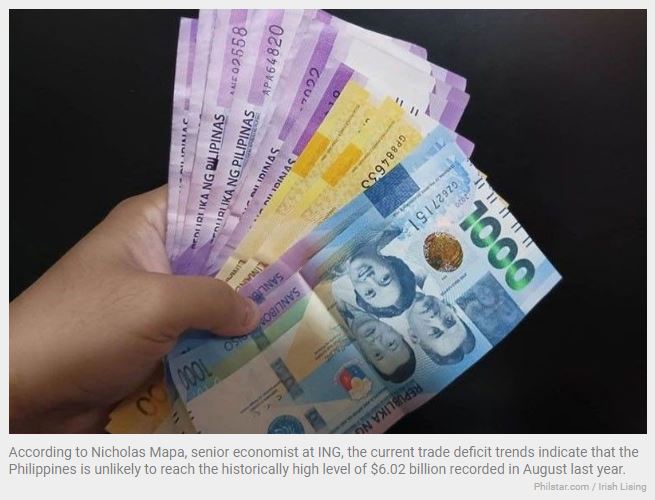Philippines: Pressure on peso weakening as trade gap narrows
MANILA, Philippines — Dutch financial giant ING expects a diminishing strain on the Philippine peso as the country’s trade deficit is anticipated to contract from its previous record highs.
According to Nicholas Mapa, senior economist at ING, the current trade deficit trends indicate that the Philippines is unlikely to reach the historically high level of $6.02 billion recorded in August last year.
Latest data from the Philippine Statistics Authority (PSA) showed that the trade gap narrowed to $4.53 billion in April from $5.32 billion in the same month last year and the $5.1 billion recorded last March.
The country’s trade deficit rose by 4.8 percent to $19.28 billion in the first four months of the year from $18.4 billion in the same period last year as exports declined by 14.9 percent to $21.77 billion while imports contracted by 6.7 percent to $41.05 billion from $43.98 billion.
Mapa said the outlook for exports is not particularly upbeat, with regional trading partners also reporting challenges for the electronics sector. Given the size of electronics exports in the total, he said exports are expected to be lower at least in the near term.
He likewise pointed out that imports are moving in line with expectations that first quarter gross domestic product (GDP) growth would likely be the highest for the year.
“There will be a fundamental pressure on the Philippine peso to weaken somewhat. However, we do not expect the currency to face the same amount of pressure experienced in mid-2022,” Mapa said.
The peso slumped to an all-time low of 59 to $1 in October last year amid the aggressive rate hikes delivered by the US Federal Reserve to fight inflation, and due to the strong demand for dollars amid the further reopening of the economy with the lifting of strict COVID quarantine and lockdown protocols.
The peso rebounded to the 52 to $1 level in February, making it the best performing currency in the region. But it has since weakened to the 56 to $1 level due to the tightening cycle of the BSP to maintain a healthy interest rate differential with the US as well as its active intervention in the foreign exchange market.
Since the end of last year, the local currency has weakened by 0.5 percent to 56.05 to $1 last Friday from the end-2022 level of 55.755.
In its 185th meeting, the Development Budget Coordination Committee (DBCC) narrowed down its peso-dollar exchange rate assumption for 2023 to 54 to 57 per $1 from 53 to 57 for this year.
The DBCC expects the local currency to be broadly stable at the 53 to 57 range between 2024 and 2028.
“The peso will continue to be supported by structural foreign exchange inflows and ample international reserves,” the DBCC said.
The DBCC lowered its goods exports and imports growth projections for this year to one percent and two percent from three percent and four percent, respectively, following the trend in near-term global demand outlook and trade prospects.
These are expected to stabilize at six percent and eight percent, respectively, in the medium term.
Source: https://www.philstar.com/business/2023/06/13/2273368/pressure-peso-weakening-trade-gap-narrows


 English
English




